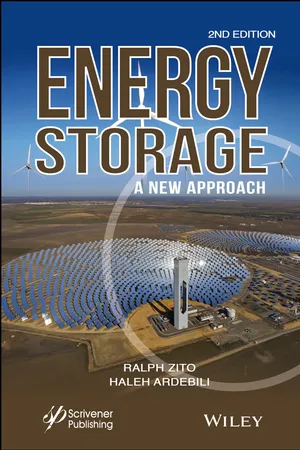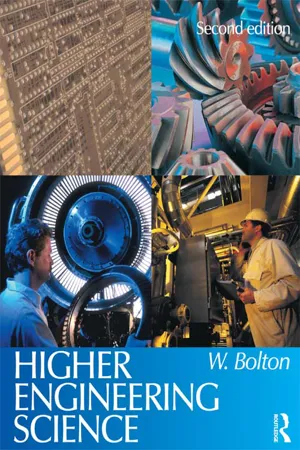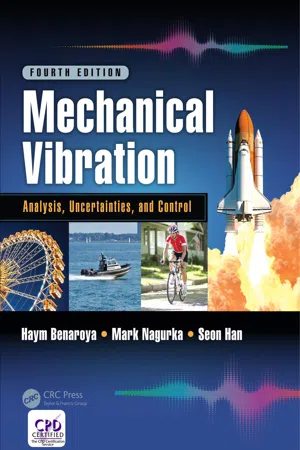Conservation of Mechanical Energy
The conservation of mechanical energy states that in a system where only conservative forces are acting, the total mechanical energy (the sum of kinetic and potential energy) remains constant over time. This principle is derived from the work-energy theorem and is a fundamental concept in physics, often used to analyze the motion of objects and systems.
6 Key excerpts on "Conservation of Mechanical Energy"
- eBook - ePub
- Hani M. Tawancy, Anwar Ul-Hamid, Nureddin M. Abbas(Authors)
- 2004(Publication Date)
- CRC Press(Publisher)
...This is known as the principle of conservation of energy. In all mechanical processes, the sum of potential and kinetic energy of the system remains constant, i.e., However, since the force of friction is dissipative, i.e., nonconservative, it is not included in the above summation. An equivalent statement is that excluding nonconservative forces, the gain in kinetic energy of a system must be equal to the loss of potential energy during any process. 3.7 Concept of Machines Mechanical work as defined by Eq. (3.8) is a compound concept because it is the product of force and length. It follows that a given amount of work W can be defined in a variety of ways. A small force multiplied by large displacement is equivalent to a large force multiplied by a small displacement, i.e., where Fļ < F2 and L1 > L 2. Equation (3.13) can be rewritten as: Physically, Eq. (3.14) means that when a given amount of work is done, a “force advantage’’ becomes possible if a ‘‘displacement disadvantage’’ can be tolerated. This is the basic principle involved in constructing machines. By definition, a machine is a device used to multiply force at the expense of a displacement or to change the direction of a force. According to the principle of energy conservation, a machine cannot do more work than is done on it. In practice, however, as a result of the forces of friction introduced by different working parts of the machine, a corresponding amount of the work done on the machine becomes unavailable to be done by the machine, i.e., the machine always does less work than done on it, leading to the idea of efficiency in engineering design. By definition, the efficiency of any machine is expressed as Efficiency of a machine = work output/work input Engineering products are designed such that they remain in a state of “mechanical equilibrium’ during service...
- eBook - ePub
- Emile Meyerson(Author)
- 2013(Publication Date)
- Routledge(Publisher)
...It is certainly remarkable that during all the discussions which took place in the seventeenth and eighteenth centuries on the question of the measure of force, measure and conservation should have been absolutely confused. If a force (we say, an energy) is able to bring about a certain effect, the force which can exercise an identical effect must be counted equal to the first; but it does not follow that the force must equal its effect. Now, it is this second formula, as we can easily perceive, which is at the bottom of the discussions under consideration. Finally, it is clear that the discovery of Mayer and of Joule only substituted one concept of constancy for others, already pre-existing, which it destroyed by that very fact. Leibniz supposed mechanical energy to be indestructible and, on the other hand, Deluc, Black, and Wilke admitted the indestructibility of heat-matter. What we call the principle of the conservation of energy consists in the opposite proof, namely, that heat as well as mechanical energy, taken separately, can be created and destroyed, the disappearance of mechanical energy being accompanied by the appearance of a certain quantity of heat energy and vice versa. We come to analogous conclusions through a close examination of the concept of energy, such as we find it in science of to-day. The concept of mass is only the expression of the relation following which bodies act upon each other. This action, really, is strictly determined: it is mechanical action; the relation would be entirely different were we to take for a basis electric or thermal action. Yet, because of the preference which we accord to phenomena of displacement over all others, the concept of mass certainly appears to us as invested with particular importance (p. 179 f.)...
- eBook - ePub
Energy Storage
A New Approach
- Ralph Zito, Haleh Ardebili(Authors)
- 2019(Publication Date)
- Wiley-Scrivener(Publisher)
...Even the concept of straight lines is rather intuitive in nature. Perhaps the best definition is that a force is required to change the motion of a body. Many problems arise in finding acceptable definitions for the basic parameters of physical science, namely, the abstract concepts of mass, time, force, and energy. However, we must learn to be satisfied with definitions that leave something to be desired in order to move on toward generating a working body of mechanics that enables us to design and build practical devices that serve our purposes. An interesting definition of energy comes from the Grolier Encyclopedia, which states: Energy can be measured in terms of mechanical work, but because not all forms of energy can be converted into useful work, it is more precise to say that the energy of a system changes by an amount equal to the net work done on the system … In classical physics, energy, like work, is considered a scalar quantity; the units of energy are the same as those of work. These units may be ergs, joules, watt-hours, foot-pounds, or foot-poundals, depending on the system of units being used. In modern science, energy and the three components of linear momentum are thought of as different aspects of a single four-dimensional vector quantity, much as time is considered to be one aspect of the four-dimensional space-time continuum … Energy exists in many different forms. The form that bodies in motion possess is called kinetic energy. Energy may be stored in the form of potential energy, as it is in a compressed spring. Chemical systems possess internal energy, which can be converted by various devices into useful work; for example, a fuel such as gasoline can be burned in an engine to propel a vehicle. Heat energy may be absorbed or released when the internal energy of a system changes while work is done on or by the system...
- W. David Yates(Author)
- 2020(Publication Date)
- CRC Press(Publisher)
...15 Mechanics In this chapter, we will discuss and review the equations listed on the Board of Certified Safety Professionals (BCSP) examination reference sheet 1 related to mechanics. Our primary focus will be on the equations related to energy, work, force, and velocity. Mechanics can be defined as the study of the relationships between motion, forces, and energy. As a safety professional, you must have a thorough working knowledge of this science in order to adequately perform the basic responsibilities of your position. Energy We will discuss two types of energy in this chapter, potential energy and kinetic energy. The laws of energy are as follows: The first law of thermodynamics says that energy under normal conditions cannot be created or destroyed, simply transformed from one type of energy to another (also known as the law of conservation); The second law of thermodynamics is a bit more complex than the first law, but basically states that any time you do work, including any time you make an energy transformation, some of the starting energy is going to be lost as heat. Kinetic Energy Kinetic energy is the energy of motion. An object that has motion, whether it be vertical or horizontal motion, has kinetic energy. There are many forms of kinetic energy, which include vibrational, rotational, and translational (energy due to motion from one location to another). The basic equation to determine kinetic energy is written as K.E. = m v 2 2 or written another way: K.E. = 1 2 m v 2 where K.E. = kinetic energy (N) m = mass of the object v = speed of the object (velocity) Note: An important conversion to remember is that 1 newton (N-m) = 1 kg (m/s 2) and 1 N-m = 1 J/m Example Determine the kinetic energy of a 625-kg roller coaster car that is moving with a speed of 18.3 m/s. K.E. = 625 kg (18.3 m/s) 2 2 K.E. = 625 kg (334.89 m / s 2) 2 K.E. = 209, 306.25 2 K.E. = 104, 653.13 kg (m / s 2) or 1.05 × 10 5 N Note: Kinetic energy is measured in joules...
- eBook - ePub
- William Bolton(Author)
- 2012(Publication Date)
- Routledge(Publisher)
...5 Energy transfer 5.1 Introduction This chapter is concerned with the energy transfers that can occur with mechanical systems. Energy can be transferred from one form to another by work being done or by heat transfer. Here we restrict the discussion to transfers involving work. There are many forms that energy can take and in this chapter potential energy, linear and angular kinetic energy and strain energy are discussed and the principles applied to the solution of mechanical system problems. 5.1.1 Conservation of energy There is a basic principle that is used in all discussions of energy and that is that energy is never lost, it is only transformed from one form to another or transferred from one object to another. This is the principle of the conservation of energy. In any process we never increase the total amount of energy, all we do is transform it from one form to another. The principle of the conservation of energy is that energy is never created or lost but only converted from one form to another. In all such conversions, the total amount of energy remains constant. 5.2 Work Work is said to be done when the energy transfer takes place as a result of a force pushing something through a distance (Figure 5.1), the amount of energy transferred W being the product of the force F and the displacement s of the point of application of the force in the direction of the force. Figure 5.1 Work Work done by a constant force W = Fs [1] With force in newtons and distance in metres, the unit of work is the joule (J) with 1 J being 1 N m. Consider the work done by a force F when the resulting displacement s is at some angle 0 to the force (Figure 5.2). We can look at this in two equivalent ways. We can consider the displacement in the direction of the force F is s cos θ and so the work done is: work done = F × s cos θ [2] Figure 5.2 An oblique force Alternatively, we can consider the force component acting in the direction of the displacement...
- eBook - ePub
Mechanical Vibration
Analysis, Uncertainties, and Control, Fourth Edition
- Haym Benaroya, Mark Nagurka, Seon Han(Authors)
- 2017(Publication Date)
- CRC Press(Publisher)
...In this equation, both the work and the kinetic energy are scalars. The kinetic energy of a particle is defined as the total work that must be done on the particle to bring it from a state of rest to a velocity r ˙. Thus, for v = | r ˙ |, T = ∫ 0 v m v d v = 1 2 m v The work done by the conservative force can be related to the change in position of the mass. To develop this relationship, we first introduce the concept of conservative force field as one where the work done depends only on the initial and final positions of the particle and is independent of the path connecting these positions. An example of a conservative force field is gravity. Nonconservative forces, such as friction—which is energy ‐ dissipating ‐external forces and forces that depend on velocity, are functions that depend on more than position. The work done by nonconservative forces is path‐dependent. From Figure 5.2, any path within the conservative force field that connects points 1 and 2 can be selected, and the work done in changing the particle’s position from 1 to 2 will be the same regardless of the path chosen. Denoting this as conservative work, W 12, it can be expressed as W 12 c = ∫ r 1 r 2 F · d r ⏟ Path I = ∫ r 1 r 2 F · d r ⏟ Path II Figure 5.2. Paths in a conservative force field. Any path chosen between points 1 and 2 results in the same work done. Time is not a parameter here. If we denote the potential energy associated with position r 1 to be V (r 1), then we can define the potential energy as the negative of the work done by a conservative force to move an object from its reference position r p to a current position, r 1, V (r 1) = - ∫ r p r 1 F. d r. The work done moving a particle in a conservative force field can now be related to the potential energy of the particle. We consider again W 12 c but choose an arbitrary path through reference position r p...





